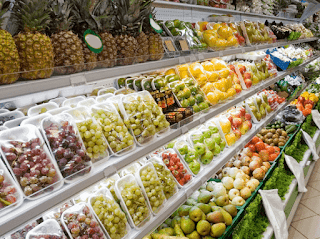Packaging fresh fruits and vegetables are one of the more important topics in the long and complicated journey from grower to consumer. Bags, crates, hampers, baskets, cartons, bulk bins, and palletized containers are convenient containers for handling, transporting, and marketing fresh produce. More than 1,000 different types of packages are used for products in the U.S. and the number continues to increase as the industry introduces new packaging materials and concepts. Although the industry generally agrees that container standardization is one way to reduce cost, the trend in recent years has moved toward a wider range of package sizes to accommodate the diverse needs of wholesalers, consumers, foodservice buyers, and processing operations.
Packing and packaging materials contribute a significant cost to the produce industry; therefore packers, shippers, buyers, and consumers have a clear understanding of the wide range of packaging options available. This fact sheet describes some of the many types of packaging, including their functions, uses, and limitations. Also included is a listing, by commodity, of the common produce containers standard to the industry.
A growing number of U.S. markets and many export markets have waste disposal restrictions for packaging materials. almost all product packaging will be recyclable or biodegradable, or both. Many of the largest buyers of fresh produce are also those most concerned about environmental issues.
The trend is toward greater use of bulk packages for processors and wholesale buyers and smaller packages for consumers. There are now more than 1,500 different sizes and styles of produce packages.
High-quality graphics are increasingly being used to boost sales appeal. Multi-color printing, distinctive lettering, and logos are now common.
The container must enclose the produce in convenient units for handling and distribution. The produce should fit well inside the container, with little wasted space. Small produce items that are spherical or oblong (such as potatoes, onions, and apples) may be packaged efficiently utilizing a variety of different package shapes and sizes. many produce items such as asparagus, berries, or soft fruit may require containers specially designed for that item.
The package must protect the produce from mechanical damage and poor environmental conditions during handling and distribution. To produce buyers, torn, dented, or collapsed produce packages usually indicate a lack of care in handling the contents. Produce containers must be sturdy enough to resist damage during packaging, storage, and transportation to market.
Produce destined for export markets requires that containers be extra sturdy. Air-freighted produce may require special packing, package sizes, and insulation. Marketers who export fresh produce should consult with freight companies about any special packaging requirements. Additionally, the USDA and various state export agencies may be able to provide specific packaging information.
Damage resulting from poor environmental control during handling and transit is one of the leading causes of rejected produce and low buyer and consumer satisfaction. Each fresh fruit and vegetable commodity has its requirements for temperature, humidity, and environmental gas composition.
Produce containers should be produced friendly – helping to maintain an optimum environment for the longest shelf life. This may include special materials to slow the loss of water from the produce, insulation materials to keep out the heat, or engineered plastic liners that maintain a favorable mix of oxygen and carbon dioxide.
The package must identify and provide useful information about the produce. It is customary (and may be required in some cases) to provide information such as the product name, brand, size, grade, variety, net weight, count, grower, shipper, and country of origin. It is also becoming more common to find included on the package, nutritional information, recipes, and other useful information directed specifically at the consumer. In consumer marketing, pack-age appearance has also become an important part of the point of sale displays.
Universal Product Codes (UPC or bar codes) may be included as part of the labeling. The UPCs used in the food industry of a ten-digit machine-readable code. The first five digits are a number assigned to the specific producer (packer or shipper) and the second five digits represent specific product information such as type of produce and size of the package. Although no price information is included, UPCs are used more and more by packers, shippers, buyers, and Example of UPC retailers as a fast and convenient method of inventory control and cost accounting. Efficient use of UPCs requires coordination with everyone who handles the package.























No comments:
Post a Comment